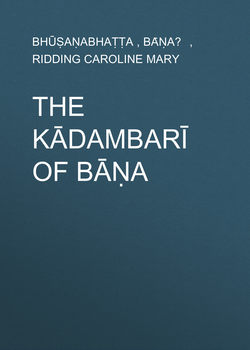Читать книгу The Kādambarī of Bāṇa - Bhūṣaṇabhaṭṭa - Страница 5
INTRODUCTION.1
The Story as told in the Kathā-Sarit-Sāgara
ОглавлениеThe story as told in the Kathā-Sarit-Sāgara of Somadeva5 differs in some respects from this. There a Nishāda princess brought to King Sumanas a learned parrot, which told its life in the forest, ended by a hunt in which its father was killed, and the story of its past life narrated by the hermit Agastya. In this story a prince, Somaprabha, after an early life resembling that of Candrāpīḍa, was led in his pursuit of kinnaras to an ascetic maiden, Manorathaprabhā, whose story is that of Mahāçvetā, and she took him, at his own request, to see the maiden Makarandikā, who had vowed not to marry while her friend was unwed. He was borne through the air by a Vidyādhara, and beheld Makarandikā. They loved each other, and a marriage was arranged between them. The prince, however, was suddenly recalled by his father, and Makarandikā’s wild grief brought on her from her parents a curse that she should be born as a Nishāda. Too late they repented, and died of grief; and her father became a parrot, keeping from a former birth as a sage his memory of the Çāstras, while her mother became a sow. Pulastya added that the curse would be over when the story was told in a king’s court.
The parrot’s tale reminded King Sumanas of his former birth, and on the arrival of the ascetic maiden, sent by Çiva, ‘who is merciful to all his worshippers,’ he again became the young hermit she had loved. Somaprabha, too, at Çiva’s bidding, went to the king’s court, and at the sight of him the Nishāda regained the shape of Makarandikā, and became his wife; while the parrot ‘left the body of a bird, and went to the home earned by his asceticism.’ ‘Thus,’ the story ends, ‘the appointed union of human beings certainly takes place in this world, though vast spaces intervene.’
The main difference between the stories is in the persons affected by the curse; and here the artistic superiority of Bāṇa is shown in his not attaching the degrading forms of birth to Kādambarī or her parents. The horse is given as a present to the hero by Indra, who sends him a message, saying: ‘You are a Vidyādhara, and I give you the horse in memory of our former friendship. When you mount it you will be invincible.’ The hero’s marriage is arranged before his sudden departure, so that the grief of the heroine is due only to their separation, and not to the doubts on which Bāṇa dwells so long. It appears possible that both this story and ‘Kādambarī’ are taken from a common original now lost, which may be the Bṛihatkathā of Guṇāḍhya.6 In that case the greater refinement of Bāṇa’s tale would be the result of genius giving grace to a story already familiar in a humbler guise.
5
Translated by Mr. C. Tawney (Calcutta, 1884), vol. ii., pp. 17–26. Somadeva’s date is about A.D. 1063.
6
V. Peterson, ‘Kādambarī,’ pp. 82–96.
